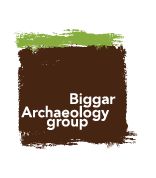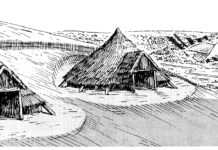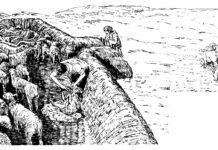
The difference between the Bastle House and the other buildings on the fermtoun will be readily appreciated. The name is derived from the French ‘bastille’ and simply means a strong or defensive place.
Bastle Houses were built exclusively with defence in mind and they were a direct response to the problem of lawlessness on the Anglo-Scottish border in the late 16th century when the infamous ‘border reivers’ ran amok, looting and murdering almost at will. Some historians have romanticised the activities of the reivers and although courageous incidents may have taken place, the reality was cowardly night attacks on often defenceless farmers and their families, many atrocities are recorded.
Landowners had their tower houses which were like mini castles, often several storeys high. Tenant farmers on the other hand could not afford such grand buildings, but it would appear that they had enough resources to build the next best thing – a bastle house, which is really a cut down version of the laird’s tower house. Thick stone walls built with lime mortar, a stout door with a protective draw bar to resist forced entry and only a few tiny windows are the characteristics of a bastle house.
Most Clydesdale examples had barrel vaulted basements and an internal stair leading up to the house part of the bastle, the ground floor being a byre for the best animals. Some Clydesdale bastles had slate roofs but here at Glenochar the roof must have been thatched.
Such buildings must have been impressive in their day in comparison to the usual type of country dwelling which could easily be assailed by an aggressor. Clearly there was a greater need of security further north of the Border than historians have previously recognised.
Contemporary documents have shown that the Glenochar farmers had large flocks of sheep and herds of cattle, exactly the type of merchandise the reivers liked to drive off stealthily by moonlight! Glenochar is on record as having been raided in 1600 when 200 cattle were driven off!
The local economy was also dependent on ready cash because silver dollars and sixpences along with many copper coins were found in the excavations.

The courtyard of the bastle had a covered drain to keep it dry and the burnt circular area may have been the remains of a corn kiln. On the other side of the burn on the steep bank there is a small patch of lazy beds which is a garden plot for growing root crops such as kail or potatoes. Two other unexcavated buildings are located near the bastle (Nos 2 and 4).
Until 1981, when the first Clydesdale example was discovered by the local archaeologists, Bastle Houses were thought to exist mainly nearer to the Border but since that time they have been identified as far north as Penicuik, near Edinburgh. It is likely that other bastle houses will yet be located.







